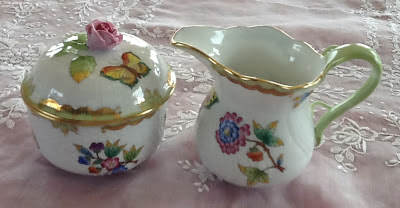Elegance for Eight
Celebrating an anniversary is a special occasion that deserves elegance and beauty. For this dinner I chose our sun room as the setting because of its round table which is great for conversation with all eight guests.
The first layer was a pin-tuck cloth to the floor in "hot" raspberry.
The next layer was a wonderful embroidered organdy square made in Belgium.
For the first course of corn from-the-garden chowder, I used vintage lavender fluted glass bowls and underplates. These come in lots of colors - pink, yellow, amber, blue, and green. Within each category, the color intensity varies. If you look closely at the first photo, you can tell some of the bowls are a pale lavender and some are almost purple. The bowls seem to be a lot easier to come by than the plates so I am always on the lookout for them.
I chose a vintage lace-edged napkin with cut work and embroidery that does not match the cloth but mixes well. Because the Herend china, "Queen Victoria," has butterflies in the floral pattern,
I used a lime green silk ribbon tucked around the napkin with a jewelry bug pinned to each. I had collected the bug pins for my mother who loved to wear a group of three at a time.
I used pale lime green and pink roses as our centerpiece in a new cut glass Waterford vase.
For the main course of lobster chunks over egg noodles in a lemon-cream sauce with steamed whole green beans from the garden, I used Herend "Princess Victoria" plates. The factory at Herend began making earthenware in 1826 and soon after began producing porcelain. Several of their pattern names came from the first purchaser. There are dinner plates in the Queen Victoria pattern, but in the 20th Century there was a demand for a plainer plate that would show off the food so they began making the Princess Victoria pattern in white with several different accent colors to choose from. Mine is green.
I used 1920's place cards but since they are not replaceable, I wrote on each in pencil so I could reuse them. You could also color copy, or scan, and print them on card stock to make extras if you find less than you need or want to keep the original unused.
The flatware is a set monogrammed "FD." I was told by the seller that it was from the New York City Fire Department. I can't verify that, but it makes an interesting story when I'm using it with guests. It's beautiful and I'm sure wasn't sitting around in some neighborhood fire station, but I like to think it was used for special fire department awards dinners or was made for the Chief. The blades are steel and do have a black tarnish that does not come off. The spoons are larger than the ones in our normal American sets, more like European soup spoons, but not as big as our tablespoons or serving spoons.
The glassware is Fostoria Sceptre in pink. I used the one on the left for our white wine and the right one for water. After one Warrenton trip, when I purchased more of these, I discovered there are ones that are similar but are a more purpley-pink. The colors are very close but if you're setting the table in the daytime, the difference becomes obvious in good light. After accidents like that, I started carrying color photos of my glassware with me when antiquing so I could make sure I had the exact right color, bowl shape, and stem shape.
I used four vintage sets of salt and pepper shakers, placing sets between every two place settings. I used two silverplate and two cut glass sets. I often buy one-of-a-kind cut glass shakers and just mix and match. As you can see in the top left photo, although the shakers match, the caps are different. One is Mother-of-pearl and the other silver.
With dessert I used a smaller version of the dinner knife and fork. I'm not sure what they would have been used for originally unless for salad or dessert. They are not the right shape to be for fish.
The full dessert place setting included the coffee cup and saucer, a coffee spoon from the "FD" set, and a liqueur glass for cognac.
I think the very prettiest piece I have in the Queen Victoria pattern is the sugar bowl with its lovely rosebud handle.
Coffee was served in a silverplate pot from the Queen Victoria time period. With its floral accents I thought it went well with the china.
Recipe for Corn Chowder with Zucchini and Orzo
4 Tbsp butter, divided
3 medium zucchini (apx. 1 1/2 lbs), in 1/2" dice
1 1/2 cups cooked orzo (3/4 cup raw, cooked 8 minutes)
2 bunches green onions thinly sliced, white and green parts kept seperate
5 cups fresh corn kernels, reserve cobs
1-32 oz box chicken broth
Saute zucchini in 2 Tbsp butter in dutch oven until crisp-tender, apx. 5 minutes. Stir in cooked orzo and 1/2 cup green onion tops. Remove all to a bowl.
Saute white part of onions in 2 Tbsp butter in same pan for 3 minutes. Add 3 cups of water and the cobs. Bring to a boil and simmer until slightly thickened, apx. 10 minutes. Remove and discard cobs. Season to taste with salt and white pepper. Add in the box of broth. Add corn and orzo mixture back into pan with broth. Bring all to a simmer.
Stir in 1/2 cup heavy cream right before serving or garnish each serving with a dollop of sour cream.



























No comments:
Post a Comment